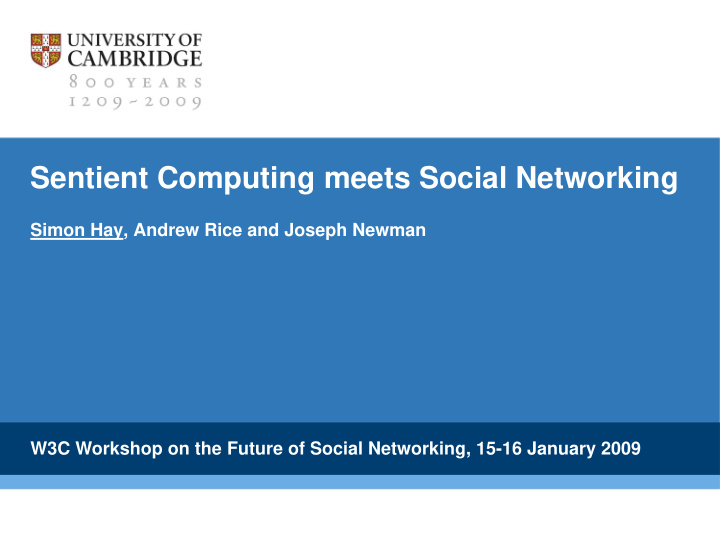



Sentient Computing meets Social Networking Simon Hay, Andrew Rice and Joseph Newman W3C Workshop on the Future of Social Networking, 15-16 January 2009
Sentient Computing “Sentient computing is the proposition that applications can be made more responsive and useful by observing and reacting to the physical world. It is particularly attractive in a world of mobile users and ubiquitous computers.” Andy Hopper, Royal Society Clifford Patterson Lecture, 1999
Shared Perceptions The world as seen by the The world as seen by users sentient computing system
Mobile Location Aware Social Networking
Ubiquitous Sensing • GSM/3G • WiFi • Bluetooth • Camera • Accelerometers • Speaker/microphone
The Active Badge System (1989-92) • infrared-based • badges emitted IR signals • receivers placed in strategic locations • room-level granularity
The Bat System
Sentient Computing Applications “Any sufficiently advanced technology is indistinguishable from magic.” Arthur C. Clarke
Whereabouts Clock
Marauder’s Map
Enhanced Interfaces
Status Updates
Context Awareness • Context must be inferred from the raw sensor data available • The inference of “Joseph is getting up from his computer” is stateful • It required knowledge of the spatial containment before and after the event itself • Instantaneous readings are not enough - we must store and utilise history
Context Awareness
Issues for discussion • Granularity to share; privacy concerns • City? Building? Room? 3 cm? • Only share inferences, not raw data? • Representing presence • Text, 2D map, 3D environment, abstraction?
Sensor Communities: NIKE+
Sensor Communities: DIY KYOTO
Thank you! Any questions? Email: sjeh3@cam.ac.uk More information: http://www.cl.cam.ac.uk/~sjeh3/social/ http://www.cl.cam.ac.uk/research/dtg
Recommend
More recommend